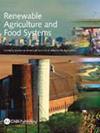巴西2003-2021年生物炭农业利用的文献计量学分析:研究现状和有前景的原料
IF 2
3区 农林科学
Q2 AGRICULTURE, MULTIDISCIPLINARY
引用次数: 1
摘要
摘要生物炭由于其多样的农艺和环境效益,被认为是发展可持续农业生态系统的一种很有前途的选择。在此背景下,本研究的目的是在农业背景下对巴西的生物炭研究进行文献计量分析,包括调查该国生产生物炭最常用的原材料。该分析是根据2003年至2020年在巴西科学网数据库(WoS核心收藏)中搜索的科学文章(同行评审论文)进行的。使用VOSviewer软件,通过对研究组成部分(作者、机构、国家和关键词)和科学制图应用描述性和度量方法进行绩效分析,以澄清巴西研究中生物炭领域的科学合作以及认知和智力结构模式。还对获得的研究进行了单独分析,以对生物炭生产中使用的不同原料进行分类。共有261篇科学文章符合筛选标准,这表明巴西生物炭出版物始于2003年,一直增加到2015年,并在2021年达到峰值。发表贡献最大的机构和作者是巴西农业研究公司(EMBRAPA)(Novotny E.)、圣保罗大学(USP)(Cerri C.)和联邦拉夫拉斯大学(UFLA)(Melo L.)。美国、西班牙、澳大利亚、德国和荷兰与巴西在生物炭研究方面的合作最多。生物炭领域与以下关键词高度相关:生物炭、热解碳、热解炭、固定化、炭黑、土壤肥力和土壤及其表征。在巴西,生物炭研究中使用最多的是植物来源的原材料,其中研究最多的是木材残留物,而来自糖能源行业的残留物(秸秆、甘蔗渣和滤饼)被认为具有很高的未来研究潜力。家禽粪便是生物炭生产中最有前景的动物废物,而生物固体的使用可以是创新的,有助于将生物炭作为解决严重城市废物卫生管理问题的一种选择。本文章由计算机程序翻译,如有差异,请以英文原文为准。
A bibliometric analysis on the agricultural use of biochar in Brazil from 2003 to 2021: research status and promising raw materials
Abstract Biochar is considered a promising option for the development of sustainable agroecosystems, due to its diverse agronomic and environmental benefits. In this context, the aim of this study was to carry out a bibliometric analysis on biochar research in Brazil within an agricultural context, including investigating the raw materials most employed for its production in the country. The analysis was conducted based on a search for scientific articles (peer-reviewed papers) at the Web of Science database (WoS Core Collection) from 2003 to 2020 specifically in Brazil. A performance analysis was carried out by applying a descriptive and metric approach concerning research constituents (authors, institutions, countries and keywords) and science mapping to clarify scientific collaborations and cognitive and intellectual structure patterns regarding the biochar domain in Brazilian research, using the VOSviewer software. The obtained studies were also analyzed individually to classify the different raw materials employed in biochar production. A total of 261 scientific articles met the screening criteria, indicating that the beginning of biochar publications in Brazil took place in 2003, increasing until 2015 and peaking in 2021. Institutions and authors with the highest publication contributions were the Brazilian Agricultural Research Corporation (EMBRAPA) (Novotny E.), São Paulo University (USP) (Cerri C.) and Federal Lavras University (UFLA) (Melo L.). The United States, Spain, Australia, Germany and the Netherlands present the most collaborations on biochar research with Brazil. The biochar domain was highly associated with the following keywords: biochar, pyrogenic carbon, pyrolysis, charcoal, immobilization, black carbon, soil fertility and soil and characterization. Raw materials of plant origin were the most employed in biochar research in Brazil, with wood residues being the most studied and residues originated from the sugar-energy industry (straw, bagasse and filter cake) identified as exhibiting high potential for future studies. Poultry litter is the most promising animal waste for biochar production, while the use of biosolids can be innovative, contributing to the consolidation of biochar as an option for serious urban waste sanitary management problems.
求助全文
通过发布文献求助,成功后即可免费获取论文全文。
去求助
来源期刊

Renewable Agriculture and Food Systems
农林科学-农业综合
CiteScore
5.20
自引率
7.40%
发文量
39
审稿时长
>36 weeks
期刊介绍:
Renewable Agriculture and Food Systems (formerly American Journal of Alternative Agriculture) is a multi-disciplinary journal which focuses on the science that underpins economically, environmentally, and socially sustainable approaches to agriculture and food production. The journal publishes original research and review articles on the economic, ecological, and environmental impacts of agriculture; the effective use of renewable resources and biodiversity in agro-ecosystems; and the technological and sociological implications of sustainable food systems. It also contains a discussion forum, which presents lively discussions on new and provocative topics.
 求助内容:
求助内容: 应助结果提醒方式:
应助结果提醒方式:


